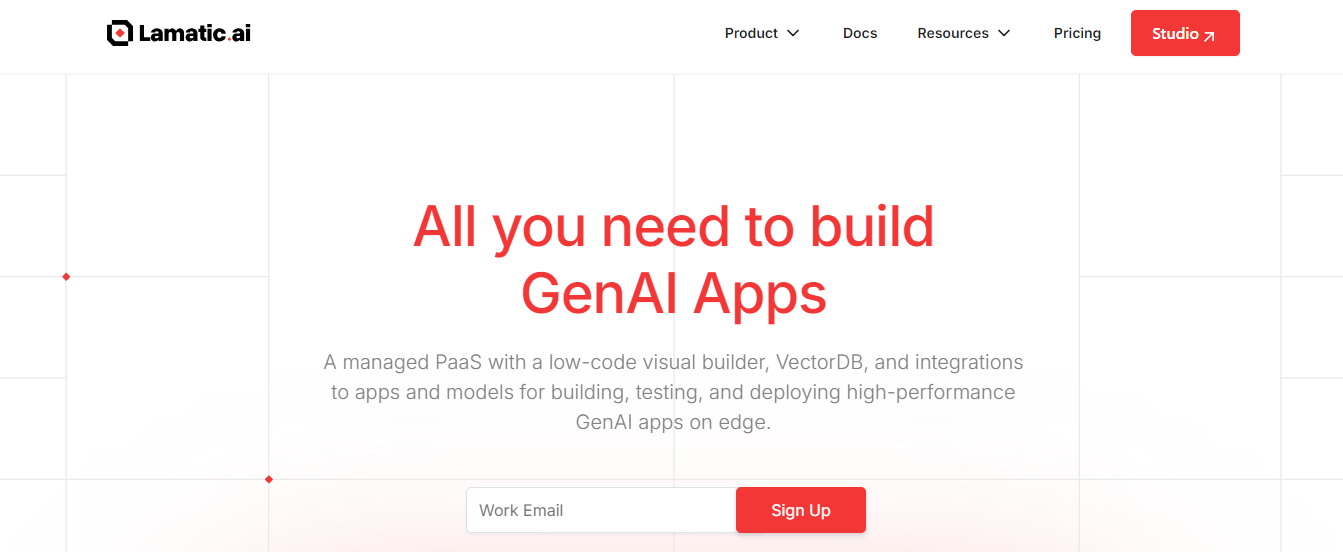The proper framework is critical for building AI applications that meet your project requirements and goals. As a developer or data scientist getting started with AI applications, you’re likely eager to find a solution that will help you get up and running quickly. With the rapid evolution of frameworks like Semantic Kernel and LangChain (also known as LangChain), it can be challenging to understand their differences, especially since they share similar functions and capabilities. Additionally, the rise of multi-agent AI systems is transforming how AI applications operate, enabling multiple AI agents to collaborate, automate complex workflows, and enhance decision-making. In this blog, we’ll closely examine the similarities and differences between these two frameworks to help you quickly and confidently choose the right AI solution for your next project.
Lamatic has developed a generative AI tech stack that simplifies building applications with Semantic Kernel or LangChain. Our solution provides transparent documentation and intuitive templates to help you get started building your AI application with your framework of choice.
What are Semantic Kernel and Langchain & Their Components?

Semantic Kernel is a tool that helps AI functions work like regular code blocks. You can plug these blocks into your applications without complex setup steps. The toolkit, developed by Microsoft, breaks down complex AI tasks into smaller, straightforward steps. Picture a set of LEGO blocks. Snap them together to add innovative features to your apps. Your code stays neat while Semantic Kernel handles the background work.The system supports C#, Java, and Python. Use your preferred language and let the plugins convert AI outputs to working code. A built-in memory system tracks data while planners map solutions for complex problems.
LangChain: The Basics and Key Benefits
LangChain creates smooth connections between AI tasks. Much like a recipe, it guides you through each step in perfect order. The framework excels at complex AI workflows. Tell it your goals, and watch it connect the dots. The system cuts down hours of coding into simple instructions.
Speed and Data Accessibility
Its strength lies in maintaining context as the system moves from one step to the next. It also integrates with external tools and data sources, allowing access to relevant information for more intelligent decisions. The system runs best on Python and JavaScript. It packs ready-made components to speed up your build time.
Semantic Kernel’s Core Components and What They Do
- Skills: Smaller, independent tasks can be used across projects.
- Memory: Stores past inputs to guide the system's response to future tasks.
- Planner: Selects and executes tasks logically based on user input.
This approach makes Semantic Kernel an efficient choice for projects that require adaptable and easily updated workflows.
LangChain’s Key Parts: A Breakdown of Tasks, Memory, and Integrations
- Chained Tasks: Connects steps to ensure smooth transitions in workflows.
- Memory Management: Tracks inputs and responses to maintain consistency throughout interactions.
- Integrations: Supports external APIs and databases for more dynamic outputs.
LangChain takes a different approach by focusing on connecting tasks in a sequence. This makes it well-suited for systems that rely on logical flows, such as chatbots or tools requiring multiple steps to conclude.
Related Reading
- What is Agentic AI
- How to Integrate AI Into an App
- Generative AI Tech Stack
- Application Integration Framework
- Mobile App Development Frameworks
- How to Build an AI app
- How to Build an AI Agent
- Crewai vs Autogen
- Types of AI Agents
Feature-By-Feature Semantic Kernel vs Langchain Comparison

Unpacking NLP: How Do Semantic Kernel and LangChain Compare?
Natural Language Processing (NLP) sits at the core of both Semantic Kernel and LangChain. Both frameworks help developers craft unique AI applications that can understand and respond to human language naturally. Nevertheless, they approach NLP differently.
Semantic Kernel
The lightweight development kit excels at kernel-based semantic function orchestration. It treats text understanding and generation as discrete tasks organized into reusable “skills.” This allows developers to build AI workflows that are both structured and adaptable.
LLM-Powered Memory
Semantic memory integration enables zero-shot context preservation without explicit prompting, particularly useful for applications where long-term data retention matters. Nonetheless, it heavily relies on large external language models (LLMs) for NLP tasks, which can slow performance when dealing with highly specific or dynamic content.
LangChain
LangChain’s prompt composition shines through its recursive chunking and Router chains. Its retrieval-augmented generation (RAG) pipeline outperforms in few-shot learning scenarios. The agent architecture makes runtime prompt optimization seamless. The tradeoff? Higher latency due to chain traversal overhead.
Final Verdict
Pick Semantic Kernel for stateless NLP tasks with strict latency requirements. Choose LangChain when you need flexible prompt optimization and don’t mind the extra milliseconds.
Workflow Automation: Do Semantic Kernel and LangChain Workflows Differ?
Workflow automation is another critical component of AI development. Once an AI application processes a user query, it must follow steps to deliver the correct output. The more complex and dynamic these workflows are, the better they can mimic human intelligence. Semantic Kernel and LangChain can help developers automate workflows to support their AI applications, but they do it differently.
Semantic Kernel
Semantic Kernel is built for flexibility. The native planner generates Directed Acyclic Graphs (DAGs) for complex workflows without explicit sequencing, making it ideal for projects where workflows must adjust quickly to changing scenarios. Nevertheless, this adaptability requires more effort during the initial setup phase, especially for developers working on smaller, time-sensitive projects.
LangChain
LangChain’s LCEL (LangChain Expression Language) lets you hot-swap components mid-execution and inject custom callbacks. The built-in routing logic handles edge cases through fallback chains. This feature is helpful for projects where workflows follow a fixed logic, such as multi-step forms or decision trees. On the downside, complex chains become hard to debug without proper tools.
Semantic Kernel is better suited for dynamic and adaptive workflows that require modular design. On the other hand, LangChain works well for linear, predefined workflows that benefit from simplicity and minimal configuration.
Integration Capabilities: Which Framework Offers More Flexibility?
Integrating with external applications and tools is critical for developing robust AI systems that can operate in the real world. Semantic Kernel and LangChain have their strengths, but cater to different integration needs.
Semantic Kernel
Semantic Kernel gives you plenty of room to customize. You can set up connectors for APIs, databases, and external tools to fit your project’s needs. It also stores workflow data to build systems that remember past interactions. The downside? It takes some profound technical know-how, which can slow things down if you want something quick and easy to set up.
LangChain
It connects with APIs and tools immediately, so you don’t have to spend time setting things up. It’s especially good at pulling data from multiple sources during a workflow, which is handy for real-time applications. On the flip side, it also doesn’t handle long-term data storage so that you might need external systems for that.
The former is best for customized, long-term integrations and projects needing persistent memory. Nonetheless, when it comes to quick setups and pulling real-time data from multiple sources, LangChain is hard to beat.
Performance and Scalability: Which Framework Handles Load Better?
Performance and scalability matter when developing AI applications. The more users interact with a system, the more requests it must process concurrently. If the application can’t handle the load, it will become slower, and the user experience will suffer.
Semantic Kernel and LangChain can perform well under pressure, but one is better suited for large-scale applications.
Semantic Kernel
Semantic Kernel’s thread-pool optimization handles concurrent requests well. Its modular design allows tasks to run independently, so you can scale without worrying about everything slowing down. Persistent memory ensures the system keeps track of what’s happened before, even as workflows grow.
The main limitation comes from its reliance on external LLMs, which can cause delays when handling heavy loads or particular tasks.
LangChain
LangChain works best in smaller, focused systems. It delivers reliable workflow performance with straightforward, step-by-step tasks, like chatbots or guided processes. These setups run efficiently and are easy to manage. Nevertheless, tightly connected task chains can become problematic as workflows become more complex. Therefore, you have to monitor the memory footprint with long-running agents constantly.
Semantic Kernel is well-suited for large-scale, adaptable systems that need to run multiple workflows at once. LangChain is suitable for smaller, sequential workflows but needs memory monitoring for long-running agents.
Workflow Orchestration: How Do LangChain and Semantic Kernel Manage Complex Processes?
Let’s talk workflow management because the way these frameworks orchestrate complex processes is where the rubber meets the road.
LangChain
Modular design allows for easy orchestration of multi-step processes, but here’s the thing: LangChain leaves much of the planning up to you. You’re responsible for defining how the chain of actions unfolds. This is great if you want maximum flexibility. Still, it can also require more legwork to ensure everything runs smoothly, especially in long-running tasks or scenarios with many decision points.
Semantic Kernel
It’s designed to orchestrate tasks and memory almost effortlessly. Semantic Kernel shines for enterprise-level workflows, where tasks are long and complex (think several steps, multiple systems, and lots of context to keep track of). It uses planners to manage the sequence of events and ensure tasks happen in the correct order.
It maintains persistent memory, allowing the AI to retain context across sessions. This retention is crucial when dealing with complex, real-world workflows that can’t afford to forget key details.
If you need fine-tuned orchestration with minimal oversight, Semantic Kernel’s built-in planners and memory capabilities give it the edge in enterprise environments.
Ease of Use and Documentation: Which Framework is More Developer-Friendly?
Here’s where things get interesting. Ease of use can make or break your experience with any framework.
LangChain
The framework is known for its developer-friendly API. The documentation is clear, the learning curve is relatively shallow, and the community is active. If you’re familiar with Python and you’ve worked with LLMs before, you’ll feel right at home. This means you can get up and running quickly, experimenting with different workflows and integrations with minimal friction.
Semantic Kernel
Conversely, it has a steeper learning curve, particularly if you’re new to integrating AI with business processes. Its focus on structured workflows and deep integration with traditional programming logic can make it feel more complex, but this complexity comes with power.
The documentation is robust, but it’s more tailored to developers working in enterprise settings, especially those familiar with Microsoft’s broader ecosystem.
If you need to get up to speed quickly, LangChain’s simplicity might be your best bet. But if you’re tackling enterprise-scale challenges, the learning curve of Semantic Kernel could pay off in terms of depth and capability.
Integration with Existing Tools/Infrastructure: Which Framework Fits Better?
Let’s discuss how well these frameworks fit into your tech stack.
LangChain
It’s highly flexible and can integrate with a wide range of tools and infrastructure. Its adaptability makes it easy to slot into startups and more traditional environments. Still, it doesn’t always come pre-optimized for enterprise infrastructure, so you may need to work to ensure everything plays nicely together, especially in more complex environments.
Semantic Kernel
It’s designed with enterprise integration at its core. It’s built to fit seamlessly into existing Microsoft ecosystems and large-scale business environments. This makes it ideal if you’re already working with Microsoft tools like Azure, Power BI, or Office 365, or need your AI solution to operate alongside existing ERP or CRM systems. It’s practically plug-and-play in enterprise settings.
Related Reading
- Llamaindex vs Langchain
- LLM Agents
- LangChain vs LangSmith
- Langsmith Alternatives
- LangChain vs RAG
- Crewai vs Langchain
- AutoGPT vs AutoGen
- GPT vs LLM
- AI Development Tools
- Rapid Application Development Tools
When to Use Langchain and When to Use Semantic Kernel

Langchain is like the Swiss Army knife of AI development:
- Flexible
- Adaptable
- Built for experimentation
It’s perfect if you’re running a startup, working in R&D, or building applications where you must prototype fast and try out new ideas. Whether creating an interactive AI agent, building a chatbot that pulls in diverse data, or handling multiple language models, Langchain allows you to experiment without feeling boxed in.
For example, you’re a startup developing an AI-driven content generator. You must test different models rapidly, connect to various APIs, and adjust the workflows. Langchain’s modular architecture allows you to do just that: Iterate quickly and change things on the fly. Its extensive support for third-party integrations means you can connect to whatever tools or data sources you need with minimal hassle.
You should reach for Langchain when you’re in exploration mode, need to build something interactive, or are dealing with multiple AI models that require frequent updates and tweaking.
When to Choose Semantic Kernel: The Precision Tool for Enterprise Applications
Semantic Kernel is like a precision machine designed for enterprise-level AI applications. Semantic Kernel is your go-to tool if your project involves scalable workflows, process automation, or integration with existing business logic.
AI Innovation with Business Logic
This framework is purpose-built for organizations that require a balance of AI innovation and business logic consistency. Think of it like this: Langchain gives you all the incredible design options if you're building a house, but Semantic Kernel ensures the foundation is solid and can handle anything you throw at it.
Enterprise AI: A Semantic Kernel Use Case
Here’s a scenario where Semantic Kernel shines: Imagine you’re working for a large corporation and need to develop an AI-driven customer support system that interacts with clients, pulls data from a CRM, updates inventory systems, and triggers follow-up actions based on customer inquiries.
Semantic Kernel: Robust Workflow Automation
With skills, planners, and memory baked into the framework, Semantic Kernel excels in handling long-running, multi-step workflows where maintaining context and automating processes is critical. If you’re dealing with enterprise workflows, need robust automation, or must ensure your AI plays nice with complex business systems, Semantic Kernel will be your best bet.
Related Reading
- Best No Code App Builders
- LLM vs Generative AI
- Langchain Alternatives
- Autogen vs Langchain
- Langflow vs Flowise
- SLM vs LLM
- Langgraph vs Langchain
- Haystack vs Langchain
- UiPath Competitors
- Agentic Definition
- AI Developers
- Best AI Models
- Best AI Coding Assistant
- LangChain Agent
- Best AI Code Generator
- AI Developer Tools
Start Building GenAI Apps for Free Today with Our Managed Generative AI Tech Stack

Building Generative AI applications is no small feat. Lamatic offers a managed Generative AI Tech Stack to help your team rapidly implement AI solutions without accruing tech debt. Our solution provides:
- Managed GenAI Middleware
- Custom GenAI API (GraphQL)
- Low Code Agent Builder
- Automated GenAI Workflow (CI/CD)
- GenOps (DevOps for GenAI)
- Edge deployment via Cloudflare workers
- Integrated Vector Database (Weaviate)
Rapid Integration and Deployment
Our platform automates workflows and ensures production-grade deployment on the edge, enabling fast, efficient GenAI integration for products needing swift AI capabilities.
With our managed generative AI tech stack, you can start building GenAI apps for free today!





